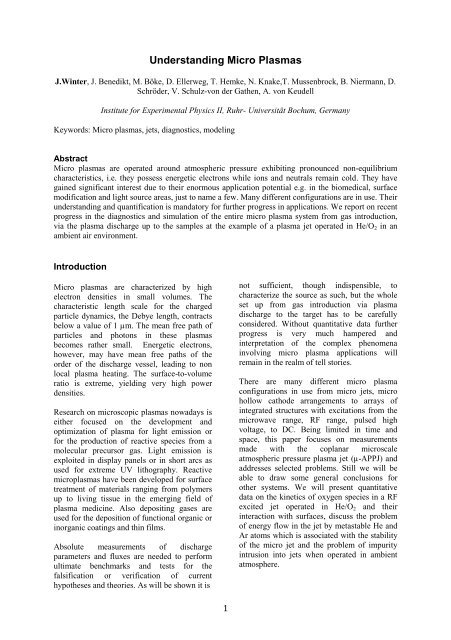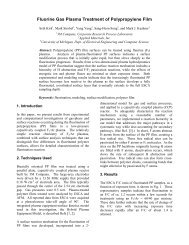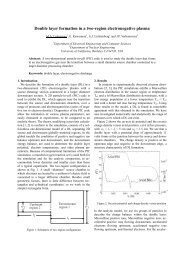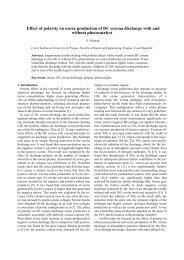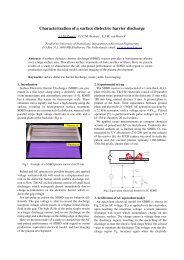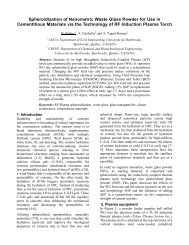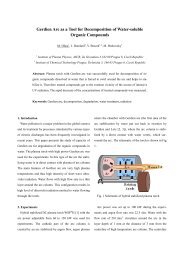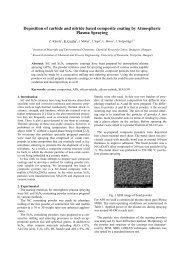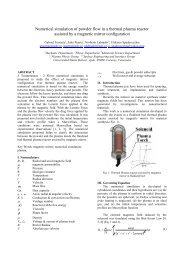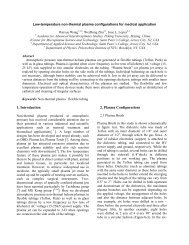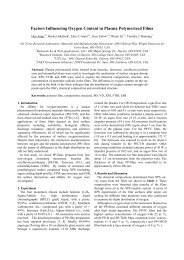Understanding Microplasmas
Understanding Microplasmas
Understanding Microplasmas
- No tags were found...
Create successful ePaper yourself
Turn your PDF publications into a flip-book with our unique Google optimized e-Paper software.
<strong>Understanding</strong> Micro PlasmasJ.Winter, J. Benedikt, M. Böke, D. Ellerweg, T. Hemke, N. Knake,T. Mussenbrock, B. Niermann, D.Schröder, V. Schulz-von der Gathen, A. von KeudellInstitute for Experimental Physics II, Ruhr- Universität Bochum, GermanyKeywords: Micro plasmas, jets, diagnostics, modelingAbstractMicro plasmas are operated around atmospheric pressure exhibiting pronounced non-equilibriumcharacteristics, i.e. they possess energetic electrons while ions and neutrals remain cold. They havegained significant interest due to their enormous application potential e.g. in the biomedical, surfacemodification and light source areas, just to name a few. Many different configurations are in use. Theirunderstanding and quantification is mandatory for further progress in applications. We report on recentprogress in the diagnostics and simulation of the entire micro plasma system from gas introduction,via the plasma discharge up to the samples at the example of a plasma jet operated in He/O 2 in anambient air environment.IntroductionMicro plasmas are characterized by highelectron densities in small volumes. Thecharacteristic length scale for the chargedparticle dynamics, the Debye length, contractsbelow a value of 1 µm. The mean free path ofparticles and photons in these plasmasbecomes rather small. Energetic electrons,however, may have mean free paths of theorder of the discharge vessel, leading to nonlocal plasma heating. The surface-to-volumeratio is extreme, yielding very high powerdensities.Research on microscopic plasmas nowadays iseither focused on the development andoptimization of plasma for light emission orfor the production of reactive species from amolecular precursor gas. Light emission isexploited in display panels or in short arcs asused for extreme UV lithography. Reactivemicroplasmas have been developed for surfacetreatment of materials ranging from polymersup to living tissue in the emerging field ofplasma medicine. Also depositing gases areused for the deposition of functional organic orinorganic coatings and thin films.Absolute measurements of dischargeparameters and fluxes are needed to performultimate benchmarks and tests for thefalsification or verification of currenthypotheses and theories. As will be shown it isnot sufficient, though indispensible, tocharacterize the source as such, but the wholeset up from gas introduction via plasmadischarge to the target has to be carefullyconsidered. Without quantitative data furtherprogress is very much hampered andinterpretation of the complex phenomenainvolving micro plasma applications willremain in the realm of tell stories.There are many different micro plasmaconfigurations in use from micro jets, microhollow cathode arrangements to arrays ofintegrated structures with excitations from themicrowave range, RF range, pulsed highvoltage, to DC. Being limited in time andspace, this paper focuses on measurementsmade with the coplanar microscaleatmospheric pressure plasma jet (µ-APPJ) andaddresses selected problems. Still we will beable to draw some general conclusions forother systems. We will present quantitativedata on the kinetics of oxygen species in a RFexcited jet operated in He/O 2 and theirinteraction with surfaces, discuss the problemof energy flow in the jet by metastable He andAr atoms which is associated with the stabilityof the micro jet and the problem of impurityintrusion into jets when operated in ambientatmosphere.1
Modelling using nonPDPSIM is in goodagreement with these data but also suggests aprime contribution of O --and O 2 in the jetwhich still has to be assessed experimentally.Fig. 7: O profiles in front of targetsFig. 5: Model calculations of charged speciesO in front of a surfaceVarious materials were exposed to the effluentof the jet at different distances and the local Odensity was measured by TALIF up to about0.1 mm before the targets. This distance waslimited by spatial access. The flow has astagnation point at the target surface, butdiverts from perpendicular to parallel flowdirection before the target, defining thus thediffusion zone across which species reach thesurface. Flow modeling indicates the diffusionzone to start at about 0.5 mm in front of theFig.6: Set up for measuring the O impingingon a surfacesurface. A simple model allowing for a fullyabsorbing wall (particle loss probabilty ß =1),a fully reflecting surface (ß=0), and an Osource at the surface (ß


